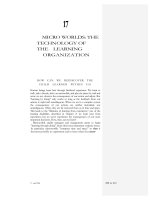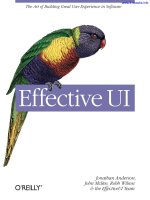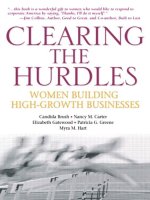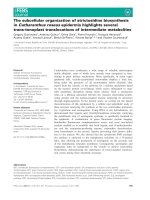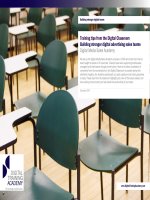the conductive organization building beyond sustainability [2004]
Bạn đang xem bản rút gọn của tài liệu. Xem và tải ngay bản đầy đủ của tài liệu tại đây (2.92 MB, 268 trang )
Further Praise for The Conductive Organization
“An evocative account of why an organization must give more than lip service to
being customer-centered and how it can implement approaches to create authen-
tic interdependence and “generalized reciprocity” between customers, partners
and stakeholders to sustain its purpose.”
—Yvon Bastien, President and General Manager, Sanofi-Synthelabo Canada, Inc.
“Saint-Onge and Armstrong’s work couldn’t have come at a better time. In an era
of growing institutional failure and emphasis on transparency, The Conductive
Organization provides a blueprint for creating organizations that are truly cali-
brated to customer needs, reliant on value-based relationships with stakeholders,
and centered on knowledge capital. An accessible read, based on theory but long
on practice, this book challenges us all to rethink strategies for how organizations
can exceed expectations.”
—Leif Edvinsson, The world’s first director of Intellectual Capital, The world’s
first holder of a professorship on Intellectual Capital, Lund University,
Sweden, 1998 “Brain of the Year”
“The Conductive Organization is that delightful rarity among management
books: a distillation of the wisdom of two obviously deeply self-reflective practi-
tioners crafted in large measure around the experiences of their own organiza-
tions but conveyed through the means of a powerful and pervasive conceptual
structure that will make academics and consultants blush with envy. And, yes, for
those managers who truly want to understand why knowledge is the ultimate
organizational asset and how to leverage it, this is the “must read” book.”
—Liam Fahey, Partner, Leadership Forum, Inc. and Adjunct Professor,
Strategic Management at Babson College
“As organizations struggle to find new ways to operate in turbulent times, Saint-
Onge and Armstrong provide us with a new way of thinking—of concentrating
on strategy-making not just strategies; on calibrating to the customer not just
becoming client-centric; on increasing knowledge flows not just gaining knowl-
edge. The Conductive Organization provides leaders at all levels with a frame-
work that is grounded in the authors’ cumulative experiences with success and
shaped by their values.”
—Tom Jenkins, CEO, Open Text
FM.qxd 3/19/04 3:49 PM Page i
“The Conductive Organization presents compelling insight on organizational
and knowledge strategies that leaders can take to gain a competitive advantage.
The premise that a connected enterprise is empowered through conductivity puts
the customer at the center. Conductivity realizes the full potential of technology,
and goes way beyond it. Any leader who wants to succeed will want to put this
book on their list of must reads.”
—Mary Lee Kennedy, Director, Knowledge Network Group,
Microsoft Corporation
“Organizational success relies heavily on the capability to leverage both institu-
tional and personal knowledge. While our systems and approaches for managing
information are for the most part highly developed, we are just starting to under-
stand the complexities of how to best utilize our personal knowledge in pursuit
of organizational goals. S.A. Armstrong Limited has been at the forefront of this
journey of discovery. This book provides insights coupled with practical applica-
tions that can guide any organization toward a more effective management and
use of its most valuable asset- the unique knowledge of its people.”
—Maseo Maekawa, Chairman of the Board, Mayekawa Mfg. Co., Ltd., Tokyo,
Japan; President, Mayekawa Holding AG, Zug, Switzerland; President,
Mycom Intertec AG, Zug, Switzerland
“This book is a personal and insightful guide for organizations wishing to better
engage with the knowledge economy. It is deeply grounded in the authors own
experiences, which makes their recommendations that much more cogent and
sensible.”
—Laurence Prusak, Distinguished Scholar in Residence, Babson College, USA
“My prediction is that The Conductive Organization will become the most con-
ductive new idea in management circles and business schools around the world.
The central idea that all organizational structures in processes must become cus-
tomer dictated is currently being written about by other authors, but only as a
theory.Where the authors differentiate themselves is in providing the actual orga-
nizational blue print for making customers permanent creative partners in the
innovation, manufacturing, and delivery processes. The Conductive Organiza-
tion book is a platform that will generate thousands of fruitful management prac-
tices and methods.”
—Dan Sullivan, President, The Strategic Coach
FM.qxd 3/19/04 3:49 PM Page ii
The Conductive Organization
Building Beyond Sustainability
FM.qxd 3/19/04 3:49 PM Page iii
This page intentionally left blank
The Conductive Organization
Building Beyond Sustainability
Hubert Saint-Onge and Charles Armstrong
AMSTERDAM • BOSTON • HEIDELBERG • LONDON
NEW YORK • OXFORD • PARIS • SAN DIEGO
SAN FRANCISCO • SINGAPORE • SYDNEY • TOKYO
FM.qxd 3/19/04 3:49 PM Page v
Elsevier Butterworth-Heinemann
200 Wheeler Road, Burlington, MA 01803, USA
Linacre House, Jordan Hill, Oxford OX2 8DP, UK
Copyright © 2004, Elsevier Inc. All rights reserved.
No part of this publication may be reproduced, stored in a retrieval system, or
transmitted in any form or by any means, electronic, mechanical, photocopying,
recording, or otherwise, without the prior written permission of the publisher.
Permissions may be sought directly from Elsevier’s Science & Technology Rights
Department in Oxford, UK: phone: (+44) 1865 843830, fax: (+44) 1865 853333, e-mail:
You may also complete your request on-line via the
Elsevier homepage (), by selecting “Customer Support” and then
“Obtaining Permissions.”
Recognizing the importance of preserving what has been written, Elsevier prints its
books on acid-free paper whenever possible.
Library of Congress Cataloging-in-Publication Data
Saint-Onge, Hubert.
The conductive organization : building beyond sustainability / Hubert Saint-Onge
and Charles Armstrong.
p. cm.
ISBN 0-7506-7735-X (alk. paper)
1. Knowledge management. 2. Organizational learning. I. Armstrong, Charles.
II. Title.
HD30.2.S234 2004
658.4¢038
–dc22
2004005149
British Library Cataloguing-in-Publication Data
A catalogue record for this book is available from the British Library.
ISBN: 0-7506-7735-X
For information on all Butterworth-Heinemann publications
visit our website at www.bh.com
0304050607080910987654321
Printed in the United States of America
FM.qxd 3/19/04 3:49 PM Page vi
A mes parents, Roland et Cécile, qui
m’ont inspiré à poursuivre mes rêves avec
courage—HSO
To Sarah and David and to three
generations of the Armstrong community
who have discovered, developed, and
lived our core values—CAA
FM.qxd 3/19/04 3:49 PM Page vii
This page intentionally left blank
Contents
Preface xi
Acknowledgements xvii
1 The Conductive Organization 1
2 The Customer Imperative 23
3 The Knowledge Capital Model 35
4 Customer Calibration 53
5 The Strategy-Making Perspective of the Conductive Organization 75
6 Internal and External Branding: The Character of the Conductive
Organization 97
7 Culture: The Collective Mindsets of the Conductive Organization 113
8 Structure: The Custodians of Conductivity 137
9 Systems: Generating Capabilities 155
10 A New Leadership Agenda for the Conductive Organization 183
11 From Conductive to Highly Conductive—The Evolving
Organization 207
Glossary 231
About the Authors 235
Index 239
ix
FM.qxd 3/19/04 3:49 PM Page ix
This page intentionally left blank
Preface
The ideas and approaches that shaped The Conductive Organization:
Building Beyond Sustainability evolved during a 10-year relationship
between two practitioners leading markedly different types of orga-
nizations. Hubert Saint-Onge was Executive Vice President, Strate-
gic Capabilities at Clarica Life Insurance Company (Clarica), a large
organization from the financial services sector, and Charles Arm-
strong was, and continues to be, President, S.A. Armstrong Limited
(Armstrong), a medium-sized corporation from the engineering
and manufacturing sector. Despite their different sector foci, in
recent years both these practitioners have grappled with the same
problem—how best to configure, and lead, organizations to enable
high and sustainable performance in the knowledge era. The Con-
ductive Organization describes the solutions they crafted and applied
within their organizations.
Intellectual Capital
When the authors first met in 1994, Hubert was head of The Lead-
ership Center, and a vice-president, for the Canadian Imperial Bank
of Commerce (CIBC), one of Canada’s leading financial institutions.
He was already a respected pioneering thinker in the then newly
emerging discipline of intellectual capital management. Hubert was
developing this field with other pioneers such as Leif Edvinsson,
then of Skandia, a Swedish insurance company, and Karl-Erik
xi
FM.qxd 3/19/04 3:49 PM Page xi
Sveiby, which had led to the articulation of a new intellectual capital
model (customer, structural, and human capital components) that
collectively delivered an organization’s financial capital. This model
would evolve into the Knowledge Capital Model, which is a key
element in this book.
Saint-Onge et al.’s thinking and approaches attracted considerable
interest worldwide, from conference organizers and the business
press alike, most notably from Fortune Magazine. An article on intel-
lectual capital, written by Fortune editor Thomas Stewart (now
himself a respected thinker in the field and editor of the Harvard
Business Review) first brought Hubert to the attention of Charles
and prompted their first meeting. At this meeting at CIBC’s Lead-
ership Centre, they discovered congruence of thinking around the
challenges ahead for organizations and an equal appetite for explor-
ing new approaches to leadership and management.
Armstrong Challenges
At the time of their 1994 meeting, Charles was five years into his
tenure as President of Armstrong, the then 61-year-old, third-
generation, family-owned organization that he leads with his brother
James.
With successful operations in the UK, USA, Europe, the Middle
East, and Canada, there was a good amount of activity in the busi-
ness in terms of structure and customer position. The brothers had
rationalized the factories into centers of excellence, focused facto-
ries, and commenced much greater interdependence between the
organizations than had previously existed. However, the brothers
realized that Armstrong’s capabilities had to be leveraged in new
ways if the organization was to compete and succeed in the follow-
ing years. Central to this approach would be establishing a self-
initiated management team, a significant challenge in an entrepre-
neurial organization where the leadership had been held in three or
four people and all decisions were upward directed.
xii Preface
FM.qxd 3/19/04 3:49 PM Page xii
Soon after the authors first met, they jointly attended a meeting
in Santa Cruz, California where a group of like-minded practition-
ers were discussing intellectual capital and its implications in busi-
ness. While there, Charles described the work under way in his
organization to rearticulate its purpose and values and recognized
from the response of the other attendees the potential power this
work held for Armstrong. Rearticulating purpose and values was a
critical component of the work at other organizations and would
soon be so at Clarica.
It also became evident from this meeting and subsequent con-
versations that existing leadership models did not support mean-
ingful and trusted delegation in organizations, but constricted their
capacity to grow. Moreover, it was becoming painfully evident that
the financial accounting systems were inadequate in accounting for
the building of capability and intangibles of the business.
Business Value
In 1995,while on a plane to Montreal with Armstrong’s cost account-
ant John Murtaugh, Charles laid out Hubert’s elements of intellec-
tual capital in a Venn diagram and began looking at the elements,
but more importantly how they overlapped. This resultant was a
practitioner’s breakthrough. Charles realized that the interaction of
the customer, structural, and human capital elements was where
value is created. This realization gave structure to the ideas Hubert
and Charles had first discussed a year earlier. Moreover, it directed
efforts to study and understand the flows between the knowledge
capital elements and the stocks of intellectual capital created.
Know Inc.
In 1997, Charles launched an organization called Know Inc. whose
purpose was to create a network of thought leaders in the area of
intellectual capital and provide them with a collaborative environ-
ment in which they could begin to structuralize their work, thereby
Preface xiii
FM.qxd 3/19/04 3:49 PM Page xiii
making it accessible to more organizations and more people.
Through the resulting toolkits, the works of practitioners such as
Karl-Erik Sveiby, Valdis Krebs, and Verna Allee were made available
for organizations to use on their intranets. Know Inc. also developed
software to help corporations better manage their intangible assets.
This ongoing collaboration between Charles and Hubert gave struc-
ture to the evolution of their thinking.
Clarica Challenges
In 1997, Hubert accepted the position of Executive Vice President,
Strategic Capabilities for what was then Mutual Life of Canada.
Mutual Life had a long, respected, and successful history, having pro-
vided investment and insurance solutions to Canadians since 1870.
However, by the mid 1990s its leadership team had agreed that, given
the speed of change and increasing competition, to further develop
the organization required demutualization and the conversion to a
shareholder-owned company, which it would achieve by 1999. If this
wasn’t enough of a change challenge, the organization was also in
the throes of acquiring the Canadian operations of the insurer
MetLife—an acquisition that would double Mutual’s size. At the
same time, becoming a stock company led to the renaming of the
organization Clarica Life Insurance Company. “Clarica” was more
than just a “name”; it was purposefully chosen to mean clarity
through dialogue, which would represent the brand promise that
would connect Clarica with its customers. Building this brand would
become another change imperative.
Clarica Profile
With offices across Canada, Clarica served more than 3 million cus-
tomers in Canada and almost a quarter of a million customers in
the USA through 8,000 agents, staff, financial planners, and group
representatives. Headquartered in Waterloo, Ontario (about 75
miles south west of Toronto), Clarica, provided a full range of
xiv Preface
FM.qxd 3/19/04 3:49 PM Page xiv
wealth management products in addition to individual retail and
group insurance. It was been named one of the top 20 knowledge
management organizations worldwide.
The following quick facts help situate Clarica in the financial ser-
vices industry at the time:
Canada’s first and oldest mutual insurance company.
Insures one in ten Canadians.
First in retail life insurance in force in the Canadian market.
Second in Canadian market share of retail insurance (based on
income from premiums).
Largest provider of corporate loans among life-insurance-
based financial institutions.
First Canadian-based mutual life insurance company to demu-
tualize.
IPO of $680 million was the second largest ever on the Toronto
Stock Exchange.
In May 2002, Clarica became part of Sun Life Financial and the
center of Canadian operations for both organizations. At the time
of the merger, Clarica’s shares were trading at almost treble the price
at their initial public offering, and its brand had been valued in
excess of $750 million. Hubert left the company at that time, and so
the work in this book is usually referred to in the past tense to reflect
the point in time when Hubert was working at Clarica.
Armstrong Profile
Headquartered in Toronto, Armstrong was incorporated in 1934
under the leadership of its founder Samuel Allan Armstrong and
remains a privately owned company. With over 600 employees
worldwide, operating six manufacturing plants on two continents,
it’s globally recognized as a leader and innovator in design, engi-
neering, and manufacturing within the fluid flow equipment indus-
try. Its products are internationally recognized for design efficiency,
Preface xv
FM.qxd 3/19/04 3:49 PM Page xv
long service life, and operating economy. Products include: com-
mercial pumps, residential and light commercial hydronics, and fire
pumps. These products are used in residential, commercial, and
industrial installations in some of the world’s premier facilities.
In 2002, and again in 2003, Armstrong was named as one of
Canada’s 50 Best Managed Companies. More than anything this is
testament to the progress the corporation has made toward becom-
ing a more highly conductive organization.
The Collaboration Continues
The collaboration between Hubert and Charles further evolved in
2002 when Hubert accepted an invitation to join Armstrong’s man-
agement board as Executive Vice-President, Strategic Capabilities,
with the responsibility for enhancing Armstrong’s organizational
capabilities and leveraging its e-business platform. Hubert had been
involved in Armstrong’s strategy session groups since 1998.
Hubert also assumed the role of Co-Chairman at Konvergeand-
Know, of which Charles is the founder and chairman. Headquar-
tered in Toronto, KonvergeandKnow develops fully integrated
knowledge strategies based on optimized business processes and
custom technology solutions. It’s the result of a merger between two
highly innovative, successful, and complementary companies, one
specializing in custom business and technology solutions (Konverge
Digital Solutions), the other in knowledge strategy and e-learning
platforms (Know Inc).
This book captures the first decade of Hubert’s and Charles’s rela-
tionship, the start of a journey toward building a highly conductive
organization.
xvi Preface
FM.qxd 3/19/04 3:49 PM Page xvi
Acknowledgements
This book reflects experiences from the majority of our working
lives—we hesitate to do the calculation of the days, weeks, months,
and years that this collectively represents.
Our thinking has been shaped by hundreds of colleagues, practi-
tioners, and researchers, but we’d particularly like to acknowledge
the contributions of Karl-Erik Sveiby, Verna Allee, Charles Savage,
Leif Edvinsson, Valdis Krebs, Eric Vogt, Masao Maekawa, Dan Sul-
livan, Brian Hall, Margaret Logan, Barbara Annis, and Pat Sullivan
and the ICM Gathering. Having a group of colleagues such as this
has enriched our work in countless ways and helped us refine our
vision of what a highly conductive organization represents.
We’ve been fortunate to work in a variety of organizations where
we’ve gained insights from the bumps and bruises along the way
while also validating our assumptions in many successful imple-
mentations of our ideas. Without the opportunity to put our think-
ing into practice, our ideas would have remained white-board
sketches and sticky note asides. We’d like to acknowledge the staff at
Clarica Life Insurance Company and S.A. Armstrong Limited who
brought this work to reality—gave it a grounding as well as a
workout! In particular, we’d like to acknowledge Bob Astley from
Clarica and Jim Armstrong from Armstrong who have given us the
encouragement to pursue new ways of doing business, to calibrate
our organizations for breakthrough performance.
Creating the book has in itself been a significant learning experi-
ence. We’ve had to sharpen our capabilities, to put our thoughts
xvii
FM.qxd 3/19/04 3:49 PM Page xvii
together in a clear, concise manner, to try to make meaning of the
countless bits of information and ideas that we’ve amassed. The
work was truly a collaborative effort with James Creelman, Deb
Wallace, Jaylyn Olivo, and Kathy May bringing the project to life.
We’d also like to thank our editor, Karen Maloney who patiently
guided the development of the central theme.
This book is itself a reflection of a high level of conductivity. With
the quality knowledge flow between many thought leaders and prac-
titioners, we’ve been able to evolve our practice to create a new way
of doing business in the knowledge era.
xviii Acknowledgements
FM.qxd 3/19/04 3:49 PM Page xviii
1
The Conductive Organization
1
On the Move
If it’s not shifting paradigms, it’s breaking all the rules and under-
standing that the only constant is change. We’re in the midst of a
significant transition from all that we once knew about the effective
management of organizations to something we understand very
little about. The principles and concepts that we’ve studied, tested,
reengineered, and improved upon no longer meet the challenges
that current customers bring to the marketplace. With the changes
brought by the digital age, globalization, and volatile economies,
we’re searching for a whole new way of doing business. Practition-
ers, theorists, business leaders, and academics are all testing the
waters, trying to identify the components needed to build an orga-
nization that can achieve breakthrough performance in the knowl-
edge era.
We’re all a bit puzzled about what’s happening. We see very good
organizations disappear overnight—what appeared to be a healthy
organization just a year ago is now suddenly gone. We believe this
is happening, in large part, because organizations aren’t staying rel-
evant to their customers. They’re not creating and maintaining the
right combination of intangible and complementary tangible assets
or building the strategic capabilities required to meet their cus-
tomers’ needs.
To succeed, we need to understand the emerging rules of business
that will give us a much better lay of the land. Technology is short-
ch01.qxd 3/19/04 3:47 PM Page 1
circuiting all of the linear ways in which we’ve organized ourselves.
Current business leadership was largely born out of tangible asset
management that no longer applies for managing an organization’s
now more valuable intangible assets. Customers have more choices
than ever before and companies have yet to find ways of distin-
guishing themselves on something other than price and still stay in
business.
The key to evolving, to achieving sustainable breakthrough levels
of performance year after year, is to sharpen the organizational capa-
bilities needed to meet the challenges of the marketplace. As two
practitioners who’ve had the privilege of leading corporations
during the technological, economic, and social change of recent
times, we’ve had the opportunity to apply a number of new
approaches and models. We’ve evolved our thinking and tested our
theories in two distinct organizations—Clarica Life Insurance
Company (Clarica), a financial services organization, and S. A.
Armstrong Limited (Armstrong), an engineering and manufactur-
ing firm. Our positions have enabled us to test the rigor and effec-
tiveness of our approaches in different organizational contexts and
marketplaces.
Connectedness
During the past decade, we’ve seen dramatic disruptions in how soci-
eties and organizations are structured. Unparalleled technological
advances, in particular the Internet, have led to the dismantling of
much of the historically powerful barriers of time and geography.
Web-based technologies are connecting people, common interest
groups, and organizations in ways that until recently were thought
impossible. It’s not surprising that two of the most popular websites
in the world are currently Ancestry.com and FriendsReunited.com—
virtual spaces where people can connect with other people either
around the corner or around the globe.
From an organizational perspective, this ability to connect has
profound implications for how we structure, manage, lead, and
2 The Conductive Organization
ch01.qxd 3/19/04 3:47 PM Page 2
elevate our performance. With billions of bits of data and informa-
tion being transferred every second of every day, within nations and
across continents at the speed of light, a new reality is emerging. Our
stakeholders, whether they are shareholders, customers, suppliers,
employees, regulatory bodies, or social pressure groups, as well as our
competitors have instantaneous access to masses of information
about any organization. They have virtually unlimited opportunities
to share experiences and to obtain information for making choices.
This new reality is placing enormous strain on organizational
leaders in all sectors (e.g., for-profit and not-for-profit, public and
private, global and local) to gain and maintain a competitive advan-
tage or high standard of service delivery in a world where the rules
we were taught to compete by no longer make sense, or even work.
Risk Management
Just as the field formations and strategies favored by 18
th
- and 19
th
-
century generals proved to be ineffective and wasteful against 20
th
-
century arsenals, the organizational structures and principles that
were once all-powerful and provided security and profit are proving
equally ineffective and wasteful within a 21
st
-century setting. Fortune
Magazine figures from the 1990s show that only about 30% of orga-
nizational strategies were implemented successfully (1), typically
leading to the dismissal of even the most charismatic leaders. (We
can be thankful that some of the strategies that were developed were
NOT implemented. But, we’ll come back to strategy later.)
As we move through the next few years, managing the risk of
strategic failure will be an even greater priority for executive com-
mittees and, in the wake of cataclysmic business failures such as
Enron, WorldCom, and others, for their non-executive boards and
other shareholder representatives as well. External bodies will
increasingly probe corporations for evidence that risk is being
managed effectively. They’ll be looking for verification that both
external risk factors (e.g., regulatory, marketplace, customer, part-
nerships, reputation) and internal risk factors (e.g., accounting and
The Conductive Organization 3
ch01.qxd 3/19/04 3:47 PM Page 3
behavioral transparency, talent management, organizational struc-
tures, systems) are being judiciously managed.
An Opportunity for Leaders
Leaders who find effective ways to detect, mitigate, and act upon
these many pressure points will be well placed to gain competitive
advantage for their organizations going forward. In a broader sense,
they’ll also be playing an important historic role as they take orga-
nizations to their next evolutionary stage of organizing structures
and principles—a stage that is knowledge based rather than indus-
trially based and intangibly rather than tangibly driven.
Being organizational leaders at this time in history presents us
with an exciting opportunity to reconsider the old paradigms that
we were taught were the building blocks of good management and
good organizational design. We have the challenge of figuring out
what a knowledge-era organization looks like and what makes it
tick. In doing so, we’ll experiment with many new approaches. Most
likely our designs will be made up of bits and pieces from our trial
and error attempts—we’ll learn from experience what works and
what doesn’t.
The Beginning of a Conversation
Although this book describes the components we’ve found valuable
in the configuration of knowledge-era, connected organizations, we
don’t suggest that these elements will go unchallenged. Rather, we
offer them with the expectation that they’ll start a conversation
among executives, managers, and practitioners who will lead cor-
porations toward sustainable high performance. We offer to the
emerging body of thinking a starting point for discussion and exper-
imentation, not a definitive description with a prescriptive guide on
how to get there. Our belief is that no single organization is capable
of working out this complex challenge on its own. We need to col-
laborate, to contribute our collective experiences and ideas to an on-
4 The Conductive Organization
ch01.qxd 3/19/04 3:47 PM Page 4
going conversation. We need one another’s perspectives to develop
a full picture of what’s emerging.
The tools, techniques, and approaches that we outline and the lan-
guage we use transcend traditional organizational boundaries. They
are as applicable internally as they are externally. This new extended
dynamic meshes the external with the internal and offers leaders and
practitioners a new perspective on managing organizations and mit-
igating some of the risk they face in a connected world.
The Conductive Organization
As with any new thinking, we find it useful to focus our ideas
through a central, unifying image that captures and reflects our
ideas, concepts, and models. For us, an apt image for successful orga-
nizations in the knowledge era is the conductive organization.
Borrowing from the laws of science and applying them to the art
of business, we define the conductive organization as:
An organization that continuously generates and renews capabilities to
achieve breakthrough performance by enhancing the quality and flow of
knowledge and by calibrating its strategy, culture, structure, and systems to
the needs of its customers and the marketplace.
This definition highlights the key dimensions and organizational
capabilities that create the framework for our ideas. It outlines the
components that we believe need to be in place for an organization
to be viable in the knowledge era. We need to:
Continuously generate capabilities
Increase the quality and speed at which knowledge flows within
the organization and with and between our customers and
employees
Synchronize our key organizational capabilities
Calibrate our organizing structures and principles to our cus-
tomers and marketplace.
The Conductive Organization 5
ch01.qxd 3/19/04 3:47 PM Page 5
Core Organizational Capabilities in
the Conductive Organization
The knowledge era, digital age, networked economy, or any one of
the new labels given to this all-encompassing change in our lives
demands that we rethink the way we design and operate our orga-
nizations and interact with our customers. Our belief is that we do
have the capabilities to meet these challenges by assembling five core
components. These integral organizational capabilities provide a
framework to organize our collective experience through a discus-
sion of strategy, culture, structure, systems, and leadership (see
Figure 1.1). Working in strategic symmetry, fed by a highly conduc-
tive, quality knowledge flow, these capabilities form the building
blocks of the conductive organization.
Strategy
The first and foundational core organizational capability is strategy.
Achieving breakthrough performance depends, in large part, on the
extent to which the strategies and the business activities that flow
6 The Conductive Organization
C
u
s
t
o
m
e
r
M
a
r
k
e
t
p
l
a
c
e
E
n
v
i
r
o
n
m
e
n
t
Systems
Culture
Strategy
Structure
Leadership
Figure 1.1 Core Organizational Capabilities Model for the Conductive Organization
ch01.qxd 3/19/04 3:47 PM Page 6


